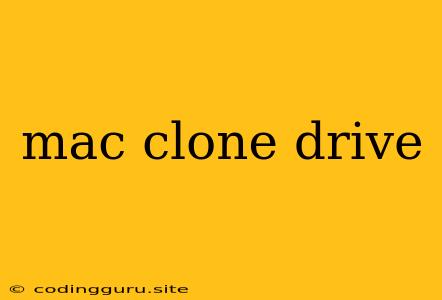Cloning Your Mac's Drive: A Comprehensive Guide
Have you ever wondered how to create an exact replica of your Mac's hard drive? Perhaps you want to upgrade your hard drive, migrate to a new Mac, or just have a backup in case something goes wrong. The answer lies in the world of Mac clone drives.
Mac clone drives are essentially duplicates of your existing hard drive, containing all your data, applications, and system settings. This allows you to easily restore your Mac to its previous state if needed, or even transfer everything to a new machine.
Why Clone Your Mac?
There are numerous reasons why cloning your Mac's hard drive is a good idea:
- Backup and Disaster Recovery: A Mac clone drive acts as a safety net, providing a complete backup of your system. In case of hardware failure, data corruption, or even accidental deletion, you can easily restore your Mac to its previous state.
- Upgrading Your Hard Drive: Want to replace your existing hard drive with a larger or faster one? Mac clone drive makes the process smooth. Simply clone your data onto the new drive, install it in your Mac, and you're good to go.
- Migrating to a New Mac: Switching to a new Mac can be a daunting task, but a Mac clone drive simplifies the process. You can transfer all your files, applications, and settings to your new Mac without having to reinstall everything manually.
- Testing New Software or Operating Systems: Before making major changes to your primary system, you can create a Mac clone drive and experiment with new software or operating systems in a safe, isolated environment.
How to Create a Mac Clone Drive
There are several methods to create a Mac clone drive. Here are some popular options:
- Using Disk Utility: Disk Utility is a built-in tool on macOS that offers basic cloning capabilities. You can use it to create a bootable clone of your entire hard drive.
- Third-Party Cloning Software: Several third-party software applications specialize in Mac cloning. These tools often provide more advanced features, including the ability to schedule automatic backups, clone specific partitions, and even perform differential backups (only copying the changes since the last clone).
- Time Machine: While primarily a backup solution, Time Machine can also be used to create a Mac clone drive. It creates a series of snapshots of your system, allowing you to restore your Mac to a specific point in time.
Choosing the Right Method for You
The best method for creating a Mac clone drive depends on your specific needs and technical skills. If you're comfortable using Disk Utility and only need a basic clone, then it's a good starting point. However, if you need more advanced features or prefer a more user-friendly interface, third-party cloning software is worth considering.
Best Practices for Cloning
- Use a Large Enough Drive: Ensure that your clone drive has enough storage space to accommodate the entire contents of your source drive.
- Back Up Your Clone: It's always wise to back up your Mac clone drive itself to an external hard drive or cloud service for added protection.
- Test Your Clone: After cloning your hard drive, it's essential to test the clone by booting from it. This ensures that your clone is functional and all data is intact.
Conclusion
Creating a Mac clone drive is a crucial step for any Mac user who wants to protect their data and ensure a smooth transition in case of unforeseen circumstances. By following the guidelines above and choosing the right method for your needs, you can create a reliable and safe backup of your Mac's system. Remember, the best time to create a Mac clone drive is before you need it!
